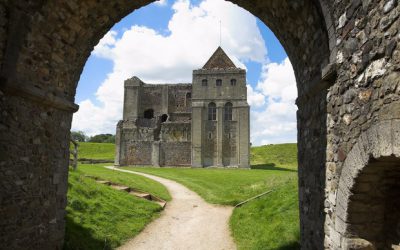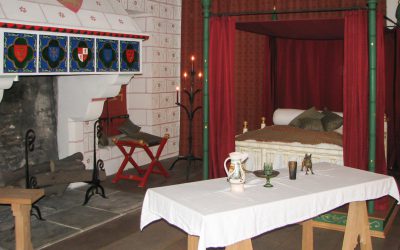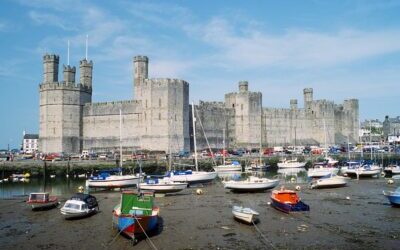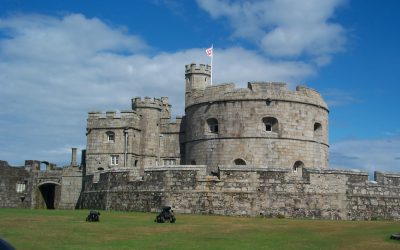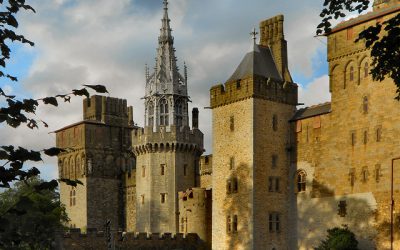Castles have played an important military, economic and social role since the Norman invasion of England in 1066. Although a small number of castles had been built in England in the 1050s, the Normans began to build motte and bailey and ringwork castles in large numbers to control their newly occupied territories in England and the Welsh Marches.
During the 12th century the Normans began to build more castles in stone, often with characteristic square keeps, that played both military and political roles. Royal castles were used to control key towns and the economically important forests, while baronial castles were used by the Norman lords to control their widespread estates. David I invited Anglo-Norman lords into Scotland in the early 12th century to help him colonise and control areas of his kingdom such as Galloway; the new lords brought castle technologies with them and wooden castles began to be established over the south of the kingdom. Following the Norman invasion of Ireland in the 1170s, under Henry II, castles were established there too.
Castles continued to grow in military sophistication and comfort during the 12th century, leading to a sharp increase in the complexity and length of sieges in England. While in Ireland and Wales, castle architecture continued to follow that of England, after the death of Alexander III the trend in Scotland moved away from the construction of larger castles towards the use of smaller tower houses. The tower house style would also be adopted in the north of England and Ireland in later years. In North Wales, Edward I built a sequence of militarily powerful castles after the destruction of the last Welsh polities in the 1270s. By the 14th century castles were combining defences with luxurious, sophisticated living arrangements and heavily landscaped gardens and parks.
Many royal and baronial castles were left to decline, so that by the 15th century only a few were maintained for defensive purposes. A small number of castles in England and Scotland were developed into Renaissance era palaces that hosted lavish feasts and celebrations amid their elaborate architecture. Such structures were, however, beyond the means of all but royalty and the richest of the late-medieval barons.
Although gunpowder weapons were used to defend castles from the late 14th century onwards it became clear during the 16th century that, provided artillery could be transported and brought to bear on a besieged castle, such weapons could also play an important attack role. The defences of coastal castles around the British Isles were improved through the Device programme to deal with this threat, but investment in their upkeep once again declined at the end of the 16th century.
Nevertheless, in the widespread civil and religious conflicts across the British Isles during the 1640s and 1650s, castles played a key role in England. Modern defences were quickly built alongside existing medieval fortifications and, in many cases, castles successfully withstood more than one siege. In Ireland, the introduction of heavy siege artillery by Oliver Cromwell in 1649 brought a rapid end to the utility of castles in the war, while in Scotland the popular tower houses proved unsuitable for defending against civil war artillery – although major castles such as Edinburgh put up strong resistance. At the end of the war many castles were slighted – deliberately damaged – to prevent future use.
Primarily used as tourist attractions, castles now form a key part of the British heritage industry. Historians and archaeologists continue to develop our understanding of British castles, while vigorous academic debates in recent years have questioned the interpretation of physical and documentary material surrounding their original construction and use.
Bibliography
Attribution
The text of this page was adapted from “Castles in Great Britain and Ireland” on the English language website Wikipedia, as the version dated 22 July 2018, and accordingly the text of this page is licensed under CC BY-SA 3.0. Principle editors have included Hchc2009, Cameron and Nev1, and the contributions of all editors can be found on the history tab of the Wikipedia article.
Photographs on this page are drawn from the Wikimedia website, as of 22 July 2018, and attributed and licensed as follows: “Motte” (Public Domain); “Thetford Castle, or Castle Mound“, author Bob Jones, released under CC BY-SA 2.0; “Castle Rising Castle“, author Dennis Smith, released under CC BY-SA 2.0; “Goodrich Castle keep1“, author Pauline Eccles, released under CC BY-SA 2.0; “Tower of London King’s room“, author Bernard Gagnon, released under CC BY-SA 3.0; “Caernarfon Castle 1994“, author Herbert Ortner, released under CC BY-SA 3.0; “Framlingham Castle reflected in the The Mere, at dawn“, author Ian Dalgliesh, released under CC BY-SA 2.0; “Pendennis Castle” (Public Domain); “Ashby de la Zouche Castle Hastings tower“, author Pahazzard, released under CC BY-SA 3.0; “Cardiff Castle from the Animal Wall“, author David Dixson, released under CC BY-SA 2.0; “Warwick Castle May 2016“, author DeFacto, released under CC BY-SA 4.0; “The Household Cavalry on parade for a state visit by the Amir of Kuwait“, author Sgt. Adrian Harlen, released under Open Government Licence v1.0.



